
Sep '09 - Oct '11
My last studio ever. And what a studio it's turning out to be...this is why I love architecture.
As a perfect follow-up to last quarter's studio with Jeff Kipnis, I am now part of visiting professor Jason Payne's research of surface sublimating form and the explorations of fur in architecture. Jason's words from a recent interview for the next issue of the KSA's One:Twelve:
The basic premise here is that I have a strong suspicion that form can be sublimated to surface; that you can actually produce strange, unforeseen form if we work the way we’re working. The one thing I have my eye on is the way that unfolds in our studio, and if basically, I think it’s proven to be the case or not. And if so, then how to make that process better or more efficient or more interesting.
I think too, more generally, I am interested in situating fur - that specific material - in architecture once again. For a long time, once the hair stuff got literal in NGTV Bar Bar where we literally used fur and there after when I was comfortable with the literal application of fur onto architecture, it typically, other than Raspberry Fields, winds up being an interiors project. That’s largely practical and pragmatic since fur comes at a scale ideal for interiors. And also, fur and hair often need protection from the elements. But I’m not totally satisfied just walking away from all of this saying, “Ok. I’ve established that fur really should stay inside.” That’s a big part of what Raspberry Fields is all about - seeing if these ideas about this material can be applied in bigger and more exterior applications. So, we’re working with these real furs and hides that have historically only been used in small scale interior applications and furniture. So, I’d imagine if I continue these studios, I'll see if there are riskier applications for real fur and real hide. And I honestly don’t know the answer to that. So we’ll see.
As a kind of narrative, Jason proposed to us that this studio was in the idea of David Bowie's The Man Who Fell To Earth.
The idea is that if David Bowie came to Earth and saw a bear skin rug, with no idea of what a bear was or looked like, and decided to analyze that fur and try to put it back into its original form, what would he come up with? Out of analyzing the hide, there would be no way for him to reform the exact bear since pieces had been removed, stretched, and manipulated. However, his result would be just as correct as that of a true bear because of the analysis that had informed the new form. Thus, creating an unimaginable form if the surface hadn't be analyzed first.
So, we all had to buy animal hides. In the studio, there is an otter, a fox, a coyote, an elk, an arctic reindeer, a muskrat, a yellow-bellied marmot, a springbok, a raccoon, a possum, and a snowshoe rabbit. I chose a goat. And I have also taken on the David Bowie narrative and am trying to approach this study of the hide with no preconceptions of what a goat looks like, which is difficult.
At first glance, the fur of a goat appears coarse, flat, and remarkably full of dander. Spotted and scratchy, the lack of pristine, shiny fur makes sense for such an animal that has been known to graze on tin cans. But no such animal sports quite a coat with such dynamic textures, varying thickness, and forceful direction as our bearded friend.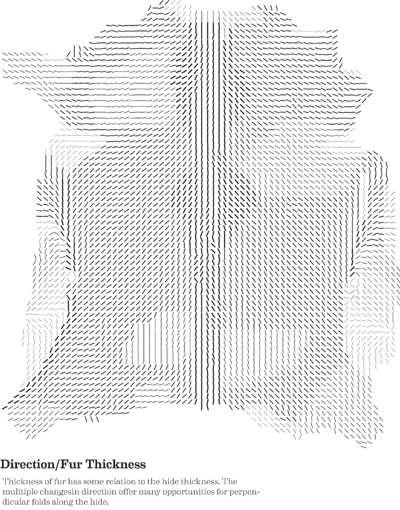
This specific hide has three supposed legs and a central spine, although the spots make it difficult to judge its center axis based on visual clues alone. Instead, it is imperative to pick up the hide and fold, poke, drape, pinch and comb it in multiple directions to gain a sense for the geometries that make the hide a function of its form. In many instances, the hide becomes quite thick and difficult to crinkle. Instead of conforming to natural curvatures, the hide almost creases as it creates rounded, geometric facets. These folds in the thicker skin allow for the self-supported structure of both longer hairs and the entire hide itself when placed on the ground. On the other hand, where the fur becomes turbulent in a whirlpool-like fashion, the skin becomes thin and amazingly soft. These areas exhibit a certain baldness, where the hair is unable to support itself and take on a much more silky quality compared to the diverging wiry hair elsewhere.
So, I created a set vocabulary for manipulating the fur based on the idea of creating more whorls in the direction of the fur.
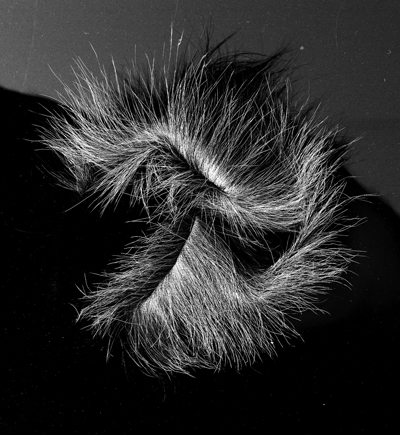
We then used a series of sheet-wax models to animate these fur characteristics. These are essentially a mannequin for the fur to be placed over. So, the wax acts as a stimulating under-form for the fur itself.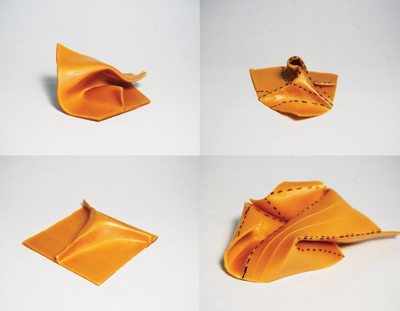
From that investigation, we built the models in Rhino and proceeded to analyze the curves through the Network Surface command, and then attempt to unfold the geometries to realize the folds needed to create these surface effects.
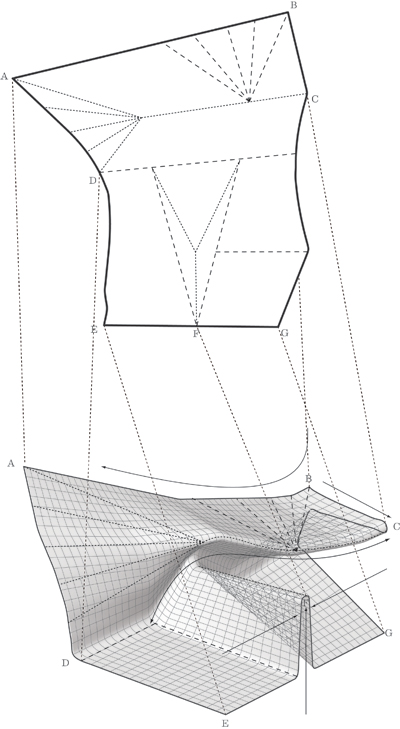
Now, three weeks from the final review, we must make a giant leap and envision what this final form is going to be before we put our new animals "out to pasture." Below are a number of studies in photographing and scanning my hide that have begun to inform my next steps in creating a new animal body.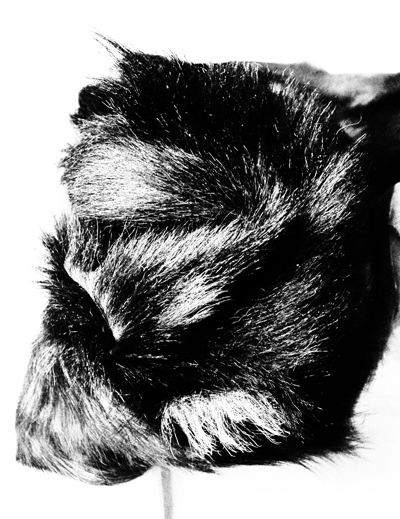

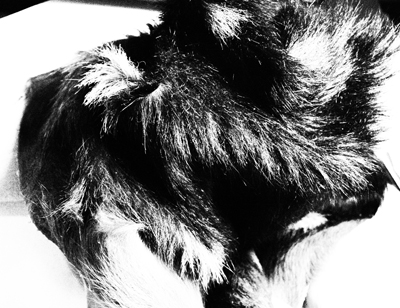
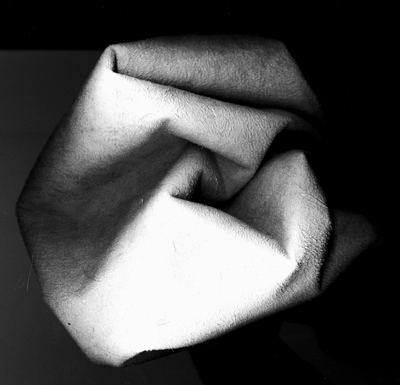
At this point, I am mostly interested in using the "pillow" technique as a way to create a sort of muscular-figurality on my animal form, while also using animal proportions to evoke a certain emotive response from the viewer; so, maybe looking at head, thorax, and abdomen. Some discussions of metal chopsticks and clamping have been made. The chopsticks are ordered. We'll see what happens.
And a shameless plug, not related to the KSA, other than a certain amount of buzzing studio culture, unless you've lived under a rock for the past week and are one of the five people who haven't gotten this album yet, go out and purchase Radiohead's The King of Limbs.
Whether or not speculations about this "Newspaper album" are correct, this record is going to prove to change the music industry once again.
Keep checking up on the KSA's lecture series as there are a number of interesting ones coming up - including this year's Baumer Visiting Lecturer Toshiko Mori.
Until next time, keep the fur alive.



5 Comments
ugh. really. fur? so boring.
cool diagrams. very weird studio premise. what was your last studio with kipnis about?
Great studio and interesting work. He comes up with the best studios here at UCLA. Can't wait to hear more about this and see the studio's collective work! Please keep us posted.
Nice post - I'm not bored of fur yet
These final two weeks are proving to be quite a challenge. We'll see how it all turns out.
Our Kipnis studio was an extension of his previous Re-laskerite studio he did last year here at OSU. Basically a post-apocalyptic society stuck in a neo-utilitarian political agenda where all forms of art and artistic expression have been deemed superfluous and wiped away from the public eye. However, a small archive of architectural projects, Jonathan Lasker paintings, and an episode of the Monty Python documentary have resurfaced with a small enclave of bohemian demimondes (us) who wish to expose the world to these pieces without being critical of the utilitarian regime through our work. Anyway, maybe I'll revisit that studio once I get it all documented and post it on here. It was definitely an educational studio, and one of the better ones I've taken.
Block this user
Are you sure you want to block this user and hide all related comments throughout the site?
Archinect
This is your first comment on Archinect. Your comment will be visible once approved.